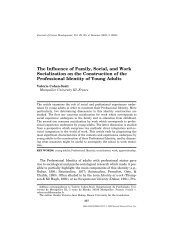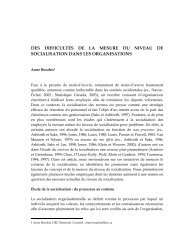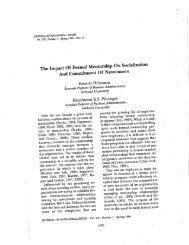Training in the 21st Century: Some Lessons from the Last One - Free
Training in the 21st Century: Some Lessons from the Last One - Free
Training in the 21st Century: Some Lessons from the Last One - Free
Create successful ePaper yourself
Turn your PDF publications into a flip-book with our unique Google optimized e-Paper software.
34 Haccoun and Saks<br />
rema<strong>in</strong>s unclear and, to date, relatively unresearched.<br />
<strong>One</strong> important exception is Calgary scholar Gattiker<br />
(1995) who reported that governmental efforts <strong>in</strong><br />
tra<strong>in</strong><strong>in</strong>g can yield positive effects on condition that <strong>the</strong><br />
tra<strong>in</strong><strong>in</strong>g be general and not firm specific. Interest<strong>in</strong>gly,<br />
firm-specific tra<strong>in</strong><strong>in</strong>g appears unattractive because it<br />
tends to be associated with high turnover. Perhaps it is<br />
<strong>the</strong> more ambitious employees who make <strong>the</strong>mselves<br />
available for tra<strong>in</strong><strong>in</strong>g opportunities precisely <strong>in</strong> <strong>the</strong> hope<br />
of accentuat<strong>in</strong>g <strong>the</strong>ir own marketability.<br />
At a time of governmental restrictions, it is especially<br />
crucial diat <strong>the</strong> effectiveness of cosdy and massive<br />
government programs be assessed and improved. Fortunately,<br />
fund<strong>in</strong>g agencies are beg<strong>in</strong>n<strong>in</strong>g to respond. For<br />
example, <strong>the</strong> Social Sciences and Humanities Research<br />
Council of Canada has funded several research proposals<br />
<strong>in</strong> die area of tra<strong>in</strong><strong>in</strong>g and, more recently it awarded a<br />
multi-million dollar strategic grant to a consortium of<br />
Canadian scholars with die express goal of establish<strong>in</strong>g<br />
"best practice" guidel<strong>in</strong>es for die development of <strong>the</strong><br />
Canadian workforce <strong>in</strong> die current context of change<br />
and employee-firm dislocations.<br />
Downsiz<strong>in</strong>g, one of die ma<strong>in</strong> developments <strong>in</strong> diis<br />
decade, has been achieved partially by enlarg<strong>in</strong>g jobs. In<br />
Canada, it is be<strong>in</strong>g achieved <strong>in</strong> a relatively civilized way,<br />
where considerations of personal worker preferences and<br />
seniority factor heavily <strong>in</strong>to die process. While it is true<br />
diat some of die vacancies created by die changes <strong>in</strong><br />
organizations were filled by younger and better educated<br />
workers, to preserve employment for as many employees<br />
as possible many new jobs were filled by current organizational<br />
members displaced <strong>from</strong> discont<strong>in</strong>ued jobs<br />
widi<strong>in</strong> dieir companies.. Moreover, functions typically<br />
performed by different employees have been fused <strong>in</strong>to<br />
new enlarged jobs (Campion & McClelland, 1991). This<br />
has accentuated tra<strong>in</strong><strong>in</strong>g's role <strong>in</strong> organizations where<br />
die tra<strong>in</strong><strong>in</strong>g system has been fundamental <strong>in</strong> prepar<strong>in</strong>g<br />
<strong>the</strong>se workers who are job naive diough organizationally<br />
seasoned for dieir new functions.<br />
<strong>Tra<strong>in</strong><strong>in</strong>g</strong> for work is a vast field diat refers to a number<br />
of different realities. It is sometimes used to update<br />
exist<strong>in</strong>g skills which may be "hard" (tra<strong>in</strong><strong>in</strong>g employees<br />
for die use of a new data base or account<strong>in</strong>g system) or<br />
"soft" (e.g. gett<strong>in</strong>g managers to communicate more<br />
effectively). It may be used to re-equip people with<br />
entirely new marketable skills (such as tra<strong>in</strong><strong>in</strong>g fishermen<br />
to become data processors) or to change specific<br />
work behaviours (such as us<strong>in</strong>g new sales techniques). It<br />
may <strong>in</strong>volve tra<strong>in</strong><strong>in</strong>g experiences diat are long, tak<strong>in</strong>g<br />
several months, or it may be very short-term and punctual<br />
(such as attend<strong>in</strong>g a sem<strong>in</strong>ar on decision mak<strong>in</strong>g or<br />
die use of die Internet). The skills taught may be relevant<br />
to a specific organization (learn<strong>in</strong>g die new performance<br />
appraisal system) or it may <strong>in</strong>volve die acquisition<br />
of skills, knowledge, and attitudes diat are relevant to<br />
work <strong>in</strong> a diversity of contexts (e.g., manag<strong>in</strong>g a multicultural<br />
workforce). F<strong>in</strong>ally, whereas tra<strong>in</strong><strong>in</strong>g is sometimes<br />
implemented to prepare workers for technological<br />
<strong>in</strong>novations, it is also frequendy employed to support<br />
organizational or cultural changes desired by top management.<br />
<strong>Tra<strong>in</strong><strong>in</strong>g</strong> and I-O Psychology<br />
I-O Psychology's role <strong>in</strong> tra<strong>in</strong><strong>in</strong>g has generally centered<br />
on die identification of die psychological mechanisms<br />
diat contribute to successful tra<strong>in</strong><strong>in</strong>g. Typically, i-o<br />
Psychologists are less <strong>in</strong>volved, professionally, with die<br />
tra<strong>in</strong><strong>in</strong>g program per se. Ra<strong>the</strong>r, diey collect data on<br />
tra<strong>in</strong>ees as <strong>the</strong>y flow dirough die tra<strong>in</strong><strong>in</strong>g and job<br />
re<strong>in</strong>sertion cycle. The <strong>in</strong>formation is dien used to<br />
evaluate tra<strong>in</strong><strong>in</strong>g effectiveness and to suggest ways of<br />
improv<strong>in</strong>g tra<strong>in</strong><strong>in</strong>g programs.<br />
Our access to organizations <strong>in</strong> order to conduct diis<br />
research is grow<strong>in</strong>g. This is <strong>in</strong> large part due to management's<br />
demand diat human resource functions such as<br />
tra<strong>in</strong><strong>in</strong>g be, like all o<strong>the</strong>r organizational systems, demonstrably<br />
effective (Belcourt, 1996-97). Industrial Psychologists<br />
work<strong>in</strong>g <strong>in</strong> die tra<strong>in</strong><strong>in</strong>g area have made significant<br />
contributions to methodological (what, how, and when<br />
to measure), substantive (how tra<strong>in</strong><strong>in</strong>g should be evaluated)<br />
, and organizational concerns (what role does die<br />
organization play <strong>in</strong> tra<strong>in</strong><strong>in</strong>g effectiveness). Along diese<br />
l<strong>in</strong>es, die journal Revue Internationale de Gestian (1997,<br />
volume 22, 3) recendy published a special issue on<br />
tra<strong>in</strong><strong>in</strong>g and features articles <strong>from</strong> a wide diversity of<br />
perspectives <strong>from</strong> North America as well as <strong>from</strong> abroad.<br />
In diis paper, we highlight die research and <strong>in</strong>terventions<br />
conducted by I-O psychologists who have contributed<br />
to understand<strong>in</strong>g and improv<strong>in</strong>g die tra<strong>in</strong><strong>in</strong>g<br />
process. We will also identify areas where gaps <strong>in</strong> our<br />
knowledge lie, and how future research and practice<br />
might be directed. Our hope, <strong>in</strong> writ<strong>in</strong>g diis paper, is<br />
diat it will prove of use not only to academics and I-O<br />
psychologists, but also to tra<strong>in</strong><strong>in</strong>g practitioners and<br />
managers.<br />
<strong>Tra<strong>in</strong><strong>in</strong>g</strong> Evaluation Design Issues<br />
Traditional tra<strong>in</strong><strong>in</strong>g evaluation designs serve to establish<br />
whedier tra<strong>in</strong>ees change and whe<strong>the</strong>r die observed<br />
change is attributable to die tra<strong>in</strong><strong>in</strong>g experience per se.<br />
The typical prescriptions come <strong>from</strong> die experimental<br />
mediod (Cook & Campbell, 1979) and require die use of<br />
control groups and or longitud<strong>in</strong>al time series. In practice,<br />
however, it has never proved easy to conduct such studies.<br />
Obta<strong>in</strong><strong>in</strong>g control groups and die random assignment of<br />
tra<strong>in</strong>ees to control and experimental groups, is well-nigh<br />
impossible to achieve <strong>in</strong> applied contexts. Time series<br />
designs tend to rely on objective data and <strong>the</strong>se are hard





